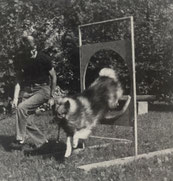Hobby & sports
How do I entertain my German Spitz in a breed-appropriate manner?
Guard dogs, like the German Spitz, were originally used to guard people's property 24/7 and to defend it against intruders. Since the popularity of the German Spitz as an only family dog is constantly increasing, many people are asking themselves how they can keep their Spitz busy in a meaningful and, above all, breed-appropriate manner.
If you want to do a hobby together with your Spitz, it is definitely advisable to take into account that the Spitz, as an ancient and primitive breed, has been specialized for its role as a guard dog for thousands of years. This specialization is also reflected in his special skills:
- The Spitz can see very well and very far,
- he has a very fine hearing
- and an excellent sense of smell,
- he has an excellent memory,
- due to his independence, he has many of his own ideas and
- amazing, but short-term, agility and jumping power.
But if you search online, for example, for ways to entertain your Spitz, you'll quickly realize that there is a lot of talk about dummy training or training with the stimulus rod. The catch, however, is that all of these activities come from the hunting dog sector. In contrast to the German Spitz, hunting dogs - as the name says - a hunting drive. However, if you prefer a Spitz who doesn't run off as soon as he sees a squirrel jumping around somewhere and who doesn't poach after the first fallow deer he sees, but who stays with you even when he's off-leash, activities that appeal to prey drive are completely unsuitable. Therefore, leisure activities should be avoided:
- trigger the prey drive,
- include strong food fixation,
because they (can) influence hunting drive.
About the Spitz's special features

A) Prey drive
The prey drive as part of the hunting cascade is used as a common element in many dog training courses, for example in retrieval or in protection dog sports, when the dog is given the bait as prey. For a dog breed like the German Spitz, which according to the official breed standard is not allowed to have any (!) hunting drive, all games that use prey stimuli are prohibited. These include tug games, fetch games, Frisbee and ball games. Now, that doesn't mean that a Spitz should never play ball. Nevertheless, caution is the key: you shouldn't play tug or ball games too often with a young Spitz or a puppy that is still developing, or even provide him with squeakers if you definitely don't want him to be interested in hunting.
B) Food fixation
The description of the German Spitz as an incorruptible guardian is no coincidence, as he tends to only take food from his master when raised appropriately. This legendary incorruptibility can be reinforced by “ad libitum feeding”, where dry food is available to the dog at all times.
I therefore strongly advise against provoking the Spitz to eat with food games (hiding food outside, for example). On the one hand, because his incorruptibility and thus his guarding service suffer, and on the other hand, because a fed-up Spitz doesn't search for food on the walk. This greatly reduces the likelihood that he will ingest poison.
In a nutshell: What are useful hobbies for a guard dog?
Hobbies or not: A thoroughbred guardian like the Spitz should generally not be prevented from guarding. This is his most favorite hobby, and it keeps him busy. Even if he apparently “just” lies around and explores the surroundings. Nevertheless, every Spitz is of course happy to do something with his or her master. For example, the following hobbies are possible:
⭐ Obedience
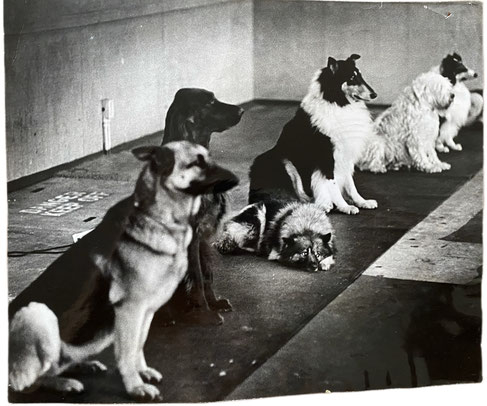
The concept of subordination respectively obedience is almost taboo in today's dog world and is more or less seen as oppression of the dog. Dogs, on the other hand, appreciate and want submission within the framework of a hierarchy because it gives them security and support. After all, the dog has joined the human and not the other way around.
In addition to everyday obedience, which in my opinion should not be missing in the training of a Spitz, obedience can also be practiced as a dog sport in a club. In addition to normal obedience, there is also the sport "Rally Obedience", which combines the elements of obstacle courses and obedience exercises.
Obedience is all about properly executing commands. The dogs' enjoyment of work is the top priority. In addition to basic training, executing the various commands given via voice and/or visual signals, the dog's controlled behavior at a distance is required. The dog has to carry out sit, stand and down commands from a distance, accept changes of direction when instructed or retrieve the one shown to it from three retrieving objects laid out. The best can demonstrate their achievements in front of a large audience at national, European and world championships.
⭐ Search game for Spitzes

Kuno is searching for the colorful ball hidden on the shelf.
The Spitz's strong photographic memory is particularly important for its role as a guard dog, because guard dogs work primarily on sight. This means that he notices even the smallest changes in the inanimate environment, which he then reports immediately. You can take advantage of this talent by letting your Spitz search for hidden objects with his eyes - instead of searching with his nose, as in the usual search games.
I show my dogs the object to look for before I hide it; after all, they have to know exactly what to look for. The dogs usually find the hidden objects surprisingly quickly and are always very proud, see Kuno's facial expression in the video after finding the ball. This Spitz-appropriate search game is suitable both indoors for rainy days and outdoors.
Breed-specific hobbies - as in this case - offers the Spitz the opportunity to train and develop his God-given superpowers. And it's just a lot of fun for him, also because he can show what he's superb at!
⭐ For the smaller ones: climbing
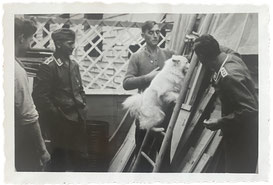
Many Spitzes can climb surprisingly well - only the larger representatives among the Wolfsspitz and Giant Spitz are usually not able to do this due to their mass. However, since not every Spitz comes up with the idea of climbing somewhere, you can help a little. Take a ladder and set it up so that it cannot tip over even with the Spitz on it. Then something tasty is attached to the top of the ladder with a thin thread (which must break as soon as the dog pulls on it). And then you just wait. At some point, Spitz will try his luck...
If your Spitz can climb ladders, you can let him climb onto the slide in the playground, for example, and then slide down it. Of course, you should ask the parents present for permission beforehand - however, the sight of a Spitz sliding down a slide is so funny that hardly anyone will be upset by it. 😉
⭐ For the large ones: Canicross & Co.

Pulling is a nice way to experience something together with your big Spitzes and is usually a lot of fun for people and dogs. However, Spitzes do not achieve particularly high speeds, nor are they particularly durable, and the Wolfsspitzes often do not take the whole thing too seriously. Where a Husky runs to the point of exhaustion, the Spitz sees pulling work as a fun option. There is a nice report about sled-pulling Wolfspitzes in Canada, who competed in a race against sleds with huskies and sheepdogs:
When the competition had long since reached the finish line, people wondered where the Wolfsspitz sleigh was. When he finally arrived, the musher explained that her lead dog "Liam" had suddenly deliberately deviated from the trail and led his companions, including the musher and sled, to the entrance steps of a house and into the kitchen, where he then enjoyed the contents of the food bowl there a living dog ate. Liam also always enjoyed the attention of the spectators by slowing down the entire sleigh and literally grinning at people. This is so typically Wolfsspitz! 🤣
It is important that you use a special pulling harness for pulling work, which is not easy to find because the Spitz has a much shorter back than the classic sled dog. I can recommend this harness, which I also use myself: pulling harness for Spitzes. You can let a scooter, Sacco-Cart or a bicycle pull you ("Bikejoring") or you can go running with them ("Canicross") or inline skate and let them pull you along. In some cases, you can reach Olympic speeds. At least as long as the Spitzes are motivated. On the way back, it usually happens for me and my dogs that I pull the dogs rather than the dogs are pulling me. 😉
In any case, it is very important for the pulling work that the dogs are well under command, otherwise it can be quite annoying. Remember that almost every dog's pulling force is at least 4 times its body weight. Therefore, the Spitz should give advance warnings like “Left!”, “Right!” and “Stop!” and master it perfectly.
I personally prefer a sport that I call "Assi-Jöring": I strap the Spitze to my canicross belt, sit on the bike and let the dogs pull at intervals, in between they run freely and comfortably on the bike.
⭐ Biking with the Spitz
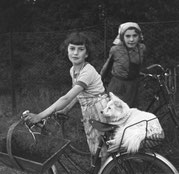
You shouldn't start cycling too early, so your young Spitz should be around 12 months old before you start letting him ride a bike. I can tell you how I structured the training: at the beginning I let the dogs run freely on the bike, but we were always out and about in the middle of the night, so as not to meet anyone. This allowed them to get used to the bike without being tied to it. Little by little, she started running besides the bike on a leash more and more often. That's all.
General information about cycling with a dog: Unless he is running freely, the dog should walk on the right side of the bike, as this is the side away from traffic. Soft ground is better for the joints than asphalt. I make sure not to overwhelm the dogs; Since Spitzes are not a trotting breed, I generally don't keep the route too long and tend to ride it at intervals, alternating between fast and slow units.
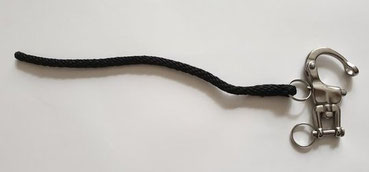
Cycling with a dog should only be done at temperatures that are not harmful to the dog. If the temperatures rise above 16°C, I no longer ride my bike with the dogs because I think they will get a little warm under their fur. When I see people letting their dogs run across the asphalt in the sun at 25°C or more - I could....🤬
If necessary, you should also think about taking water with you for when you're out and about, if you can't pass by suitable water (due to the risk of Leptospirosis, I strongly advise against letting your dog drink from puddles or other stagnant water!) - which of course also invites for a refreshing bath.
I don't like letting my dogs run while tied to my bike; They should rather find their own rhythm and not be forced to constantly adapt to my pace. Of course, I have to keep them on a leash on busy roads for their own safety. By the way, I don't believe in spacers or dog jumpers; they force the dog to always stay directly close to the bike. Imagine you have to swerve something, or you fall down on your bike - the dog is then tied up on the bike. Or the trotting dog is attacked by another dog. I want to see the person who can then unfasten the carabiner in a flash! For these reasons, I always lead my dogs using the canicross belt. If you attach a so-called “panic snap” between the belt and the leash, you can unfasten the dog from the belt in no time.
⭐ Horse and Spitz - The Spitz as riding companion
The Spitz was and is the ideal riding companion dog because it does not hunt and stays on the paths. Spitz and horse have always formed a symbiosis, as the names “Fuhrmannsspitz” (coachman's Spitz) or “Karrenspitz” (carter's Spitz) already reveal. Attentive dogs, like ours, guarded the carts at night and helped to drive the horses (or the lumbering oxen) during the day. Sometimes the dogs would jump onto the horses' broad rumps and allow themselves to be carried for a while. And alas, a stranger wanted to pet the horse: then the Spitz stood behind the collar on the horse's back and became really furious.
Even today, German Spitz are extremely suitable for running freely next to the horse. Of course, they should be trained accordingly so that they neither get between the horse's hooves nor get lost. The Spitz also needs to learn not to protect the horse or rider from hikers who they come across from time to time. Commands from the horse should really sit right.
Even as a companion on a ride, it should be noted that most German Spitzes are not physically suitable for galloping next to the horse over long distances, as their square body structure and the almost steep angulation of their extremities make them good sprinters, but only moderate endurance runners. Exceptions prove the rule, of course.
⭐ Trick dogging
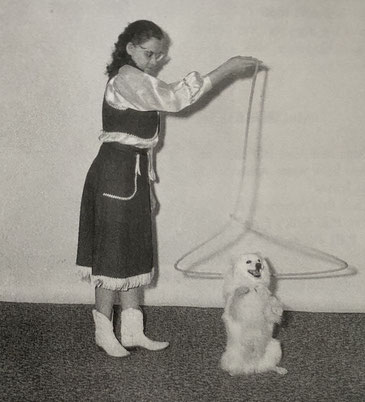
Trick training with the German Spitz, also known as "trick dogging", is a varied and fun activity opportunity for humans and Spitz. Because of its intelligence, the Spitz understands very quickly what you want him to do. However, many Spitzes tend to refuse to repeat the same exercises too often, simply because they get bored.
In a relaxed atmosphere, trick dogging involves working on little tricks and tricks together. There are a wealth of possibilities: giving a paw, ringing a bell, riding a skateboard or running through the master's legs. More advanced tricks, such as retrieving the master's socks or turning on the light switch, to complex tricks in which the Spitz can, for example, learn to open drawers in order to take something out and bring it to the master. Maybe you can teach your Spitz to fetch the newspaper, ring a bell or roll out the carpet and in the future you will have a little household helper on four paws.
Trick training is a wonderful way to keep your Spitz busy from time to time at home, perhaps when a walk has to be cancelled. The intensive “thinking” literally makes him “as tired as a dog”.
At this point I have to strongly advise against teaching the Spitz how to open doors or jump over high obstacles - unless you want a Spitz who, depending on his mood, disappears out of the house and over the garden fence to pay a flying visit to the neighborhood dogs. If not - you may be opening Pandora's box.
⭐ Protection sports? Yes, but breed-specific please!
The Wolfspitz in particular was often trained as a protection dog (Schutzhund) in the past, and in the past he also had the permission to take part in the German police dog exam - in contrast to the Giant Spitz. I don't know of any Giant Spitzes who have undergone this type of training. Maybe it's because they are normally much more choleric?
The form of training has now changed and has been adapted to the spirit of the times. While the protection dog used to be trained for attacking men, today - at the end of the teaching unit - the baiting sleeve is taken off and playfully given to the dog as prey. The dogs usually run a short distance with their sleeve and shake it violently. In itself, this type of training is rather unsuitable for our Spitz, because a Spitz does not poach; after all, the prey drive is part of the hunting cascade. You should also think carefully about whether you will be able to close this door again once it is opened. The cynologist Eberhard Wörz once wrote:
"With training on men, the greatest convenience for the dog's owner is lost. Namely, his harmlessness when dealing with humans. And with it a part of his civilization."
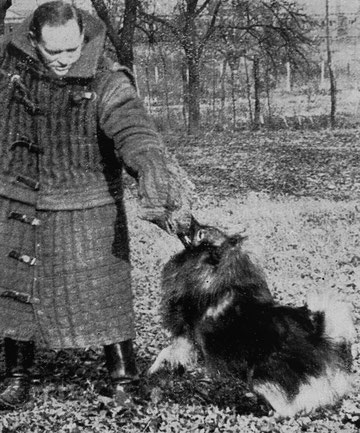
Training to become a protection dog may also be a bit too bland for a clever Spitz. Wolfspitz mistress Barbara Rumpf wrote in her article “Spitz und Hundesport" (Spitz and Dog Sports) about her experiences [1] :
"Then we practiced subordination: "walk to heel" in three gaits, "sit" from walking, staying seated until mistress picks one up, "down" from walking, staying lying down, "coming here" from "down" in front of the handler and at the command "walk to heel" next to him... Arco ("Arco vom Stux", editor's note) understood very quickly, and I was very proud of him. But there were days when he just didn't feel like it. And it took me a while until I understood that it is boring in the long run for a clever, lively Spitz to always complete the same exercises in the same order. However, in order to pass the slightest test as a "traffic-safe companion dog" (especially as a protection dog), I would have had to demand absolute obedience from my Arco, total submission. In my initial ambition, I tried a few times to force him when he didn't want to, and soon saw what the result would be: either a submissive creep with his tail hanging or a snappy oddball. I would have had to destroy his lovable, stubborn Spitz nature."
Her experiences in protection dog sport also show very clearly that not all breeds are the same, but that breed-related differences in temperament must be taken into account. A Spitz is not a German Shepherd Dog.
"Then the protection dog training: a leather-clad "mock perpetrator" with an oversized protective arm irritates the dogs so that they bite his protective arm. If they do their job well, they get their arm as a "reward". The fake perpetrator first provoked Arco with a sack, and Arco soon dragged me away with the leash in his eagerness to protect me from this monster. The latter left However, when he got rid of the sack, Arco didn't go after the sack, as was expected of him, but instead wanted to go after the handler. Actually a very sensible behavior, but there was the first negative point: "He has no prey drive". My objection that he wasn't a hunting dog, but a guard dog, was laughed at with pity. After a few more attempts, Arco also bit the protective arm. However, when the "perpetrator" got too close to him, Arco tried to pinch his heel. The second minus point: "a fear biter".
I was taught that German Shepherds bite because they enjoy it - my Arco would probably never achieve this lofty goal. But after I saw how German Shepherd Dogs attacked their own master simply because he was wearing a protective arm, and I also learned that a Rottweiler calmly watched as his master was attacked because the perpetrator was not wearing a protective arm - I would rather not have one subjugated protection dog anymore. [...] And what does it matter if he just pinches the calf and barks at a foreign intruder on our remote property - that's his job." [2]
If you still want to have your German Spitz trained as a protection dog, you will certainly find a suitable dog school near you. A very strong-nerved and environmentally friendly, as well as well-behaved Spitz is a prerequisite for this. Modern protection dog training is based purely on the dog's motivation to play, which then sees the work on the man as pure play. In theory, this means the dog cannot randomly attack someone on command, nor should it even consider doing so. Theoretically. When it comes to the Spitz, I'm not so sure whether he'll want to try out what he's learned on his own..... 😜
⭐ Agility & Degility
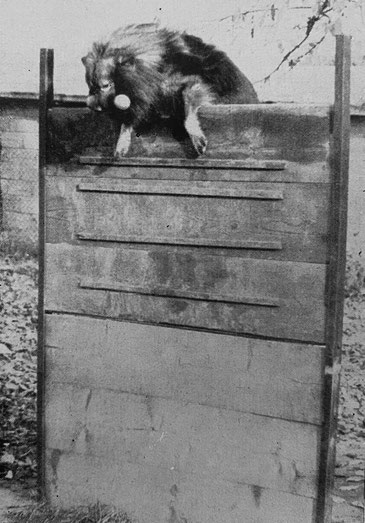
What is Agility? Agility is a dog sports in which the dog has to overcome a course consisting of several obstacles in a fixed order and within a given time. The dog handler shows him the way with body language and auditory signals, but is not allowed to touch any obstacles or the dog. Speed, dexterity and good handling are required for the Spitz.
Agility is suitable for the whole family and offers lots of fun outside. For the very ambitious, agility also offers the opportunity to demonstrate their practiced skills at large dog shows or competitions in front of audiences from all over the world. In order to be able to practice agility, the dog and owner should definitely be physically fit. If they are not, they should definitely be so in advance. One thing is certain: agility appeals to the Spitz's body and soul, but owners also have to be fit.
The agility training itself for the German Spitz should not be based on military drills; Here, the dog who cooperates happily has a clear advantage. Because of their intelligence and docility, Spitzes are basically made for agility.
Agility training is not started until the pup is 12 months old at the earliest to avoid injuries and overloading the young body. And especially with the big Spitzes you should be careful when it comes to fast agility. The more angled the hindquarters are, the more persistently a dog can jump and run. Now, according to the official standard, our Spitzes have a rather steep hindquarters. The steep hindquarters are difficult for the dog's driving dynamics because “suspension” is not very possible. Breeds like the Spitz show an astonishing acceleration and enormous jumping power due to their pelvic tilt, but they are simply not enduring. The dog also needs a certain “spring dynamic” to have the strength to jump off, which works better if there is more angulation. Medium-sized dogs with steep hindquarters - such as Giant Spitzes or Wolfsspitzes - therefore always take a certain risk when jumping excessively, as power transmission and cushioning are very difficult. Personally, I would advise against doing too fast-paced agility with the Spitz if he reaches a certain height.
“Degility” offers a nice alternative for large Spitzes: it is essentially decelerated agility, in which the teams can approach the course much more calmly because time is not a factor. At Degility, care is also taken to adapt the course to the individual abilities of each dog breed.
⭐ Dogdancing
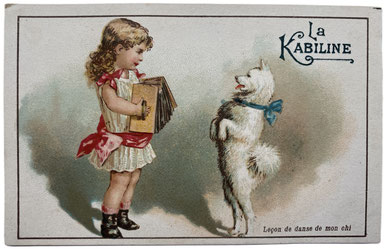
Dog dancing is a further development of obedience (see above). While obedience, which was developed in Great Britain, has existed since 1951, dog dancing is a relatively recent development and had its first breakthrough in the late 1980s.
Dog dancing as a dance between humans and dogs has now become a real trend in dog sports, in which the four-legged friends complete a rhythmic choreography to music with their owner. The elements of obedience are combined with special tricks that have to be presented through dance in such a way that a choreography that is actually beautiful to look at is created. In this video you can be amazed at how highly complex and entertaining dog dancing is.
You can do dog dancing with your dog just for fun, but you can also take part in tournaments. In principle, dog dancing is suitable for most dogs - and therefore of course also for the German Spitz.
Since the Spitz has always been used as a circus dog (especially the smaller varieties) due to its love of movement and docility and has learned many tricks and performed them in front of an audience, he will certainly have a lot of fun with dog dancing. Typical tasks in this sport include slalom running around the man's legs, walking backwards and sideways, jumps and turns, and sit up and beg. During all of these exercises, people guide their dogs using voice commands and body signals.
Conclusion
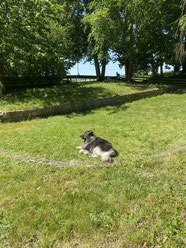
There are a bunch of ways to entertain a German Spitz - after all, he's like the Swiss Army Knife of dogs, namely one of the most versatile dog breeds there is. German Spitz dogs can be found all over the world and are rescue dogs, protection dogs, therapy dogs and circus dogs. However, one thing should not be forgotten: the German Spitz is primarily a watchdog - and the job of a watchdog is to watch! In my opinion, bike tours, dog dancing and agility competitions are not necessarily part of it, but of course you can pursue such leisure activities with your Spitz. It certainly won't hurt him as long as you don't overdo it and as long as he enjoys it. However, in principle, corresponding workloads are not necessary, because his guard duty already puts a lot of strain on him, as long as he is allowed to guard. If his owner doesn't take him to the companion dog test, to the agility tournament or to the dog park, then that doesn't mean that the Spitz is not happy or is not being kept in a species-appropriate manner.
What I don't think makes sense, however, is to advertise the German Spitz as sports equipment (e.g. as a 20 km riding companion) for the purpose of advertising and better sales. That's not him. He was and is a guard and farm dog. One of the best of its kind. 💪🏻
[1] Article from "Der Deutsche Spitz" No. 113 from 1986, written by Barbara Rumpf, p. 10 f.
[2] www.siberianhusky.de/p/panik-snap
[3] With kind permission of Britta Schweikl
[4] last-picture-show.tumblr.com
Riding video courtesy of “wanderreitenundmehr”
04.09.23
